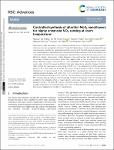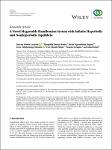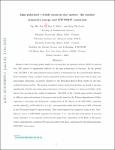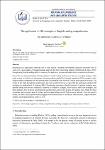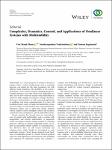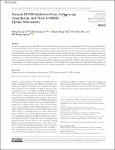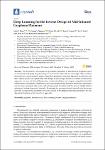Search
Author
- Tuan Q. Do (3)
- Viet-Thanh Pham (3)
- Anh D. Phan (2)
- Chu, Manh Hung (2)
- next >
Subject
- Cosmology and Nongalac... (2)
- General Relativity and... (2)
- Multistability (2)
- 2-NBDG (1)
- next >
Search Results
Fabrication of a high-performance room-temperature (RT) gas sensor is important for the future integration of sensors into smart, portable and Internet-of-Things (IoT)-based devices. Herein, we developed a NO2 gas sensor based on ultrathin MoS2 nanoflowers with high sensitivity at RT. The MoS2 flower-like nanostructures were synthesised via a simple hydrothermal method with different growth times of 24, 36, 48, and 60 h. The synthesised MoS2 nanoflowers were subsequently characterised by scanning electron microscopy, X-ray diffraction, Raman spectroscopy, energy-dispersive X-ray spectroscopy and transmission electron microscopy. The petal-like nanosheets in pure MoS2 agglomerated to form a flower-like structure with Raman vibrational modes at 378 and 403 cm−1 and crystallisation in ... |
Manganese ferrite (MnFe2O4) nanoparticles were synthesized through a coprecipitation method using manganese (II) chloride tetrahydrate (MnCl2·4H2O) and ferric chloride hexahydrate (FeCl3·6H2O) as precursors. The scanning electron microscopy images showed that the as-synthesized particles were granular and about 20 nm. The X-ray diffraction patterns revealed that the manganese ferrite phase was completely decomposed into ferric oxide (Fe2O3) and manganese (III) oxide (Mn2O3) after annealing above 800°C in air. In contrast, its crystalline quality significantly improved when it was annealed in argon. By using the vibrating-sample magnetometry technique, it was demonstrated that the saturation magnetization (M s) of the as-prepared sample (∼36.6 emu/g) decreased sharply up to ∼5 emu/g ... |
The dimension of the conservative chaotic systems is an integer and equals the system dimension, which brings about a better ergodic property and thus have potentials in engineering application than the dissipative systems. This paper investigates the phenomenon of megastability in a unique and simple conservative oscillator with infinite of hyperbolic and nonhyperbolic equilibria. Using traditional nonlinear analysis tools, we found that the introduced oscillator possesses an invariable energy and displays either self-excited or hidden dynamics depending on the stability of its equilibria. Besides, the conservative nature of the new system is validated using theoretical measurement. Furthermore, an analog simulator of the oscillator is built and simulated in the PSpice environment ... |
We study a recent proposed Ricci-inverse gravity, which is a very novel type of fourth-order gravity. In particular, we are able to figure out both isotropically and anisotropically inflating universes to this model. More interestingly, these solutions are free from a singularity problem. However, stability analysis based on the dynamical system method shows that both isotropic and anisotropic inflation of this model turn out to be unstable against field perturbations. This result indicates that the Ricci-inverse gravity might not be compatible with the inflationary phase of the universe. |
Magnetic field of rotating pulsar might be so strong that the equation of state (EOS) of neutron star (NS) matter is significantly affected by the spin polarization of baryons. In the present work, the EOS of the spin-polarized nuclear matter is investigated in the nonrelativistic Hartree-Fock formalism, using a realistic density dependent nucleon-nucleon interaction with its spin and spin-isospin dependence accurately adjusted to the Brueckner-Hartree-Fock results for the spin-polarized nuclear matter. The nuclear symmetry energy and proton fraction are found to increase significantly with the increasing spin polarization of baryons, leading to a larger probability of the direct Urca process in the cooling of magnetar. The EOS of the β-stable npeμ matter obtained at different spin ... |
The application of S2R strategies in English reading comprehension by university students in Vietnam Reading plays a significantly important role in every student’s academic development, especially when they have to work over a great number of foreign language materials for their professional subjects (McDonough & Shaw, 2013). Strengthening English reading ability is necessary for students to promote individual ability in university education. One of the most important factors affecting students’ English reading proficiency is their use of reading strategies. This study is taken to explore how Vietnamese university students applied Self-strategic regulation (S2R) strategies in their English reading comprehension. 963 students from 6 universities in the North of Vietnam participated in the study. The results of the study through the questionnaire and semi-sructured intreviews show t... |
In this paper, we extend our investigation of the validity of the cosmic no-hair conjecture within non-canonical anisotropic inflation. As a result, we are able to figure out an exact Bianchi type I solution to a power-law {\it k}-inflation model in the presence of unusual coupling between scalar and electromagnetic fields as −f2(ϕ)FμνFμν/4. Furthermore, stability analysis based on the dynamical system method indicates that the obtained solution does admit stable and attractive hairs during an inflationary phase and therefore violates the cosmic no-hair conjecture. |
Multistability is a critical property of nonlinear dynamical systems, where a variety of phenomena such as coexisting attractors can appear for the same parameters but with different initial conditions. The flexibility in the system’s performance can be achieved without changing parameters. Complex dynamics have been observed in multistable systems, and we have witnessed systems with multistability in numerous fields ranging across physics, biology, chemistry, electronics, and mechanics, as well as reported applications in oscillators and secure communications. It is now well established from a variety of studies that multistable systems are very sensitive to both random noise and perturbations. Numerous studies such as open-loop control, feedback control, adaptive control, intellig... |
Ten active principles (compounds 1-10) have been isolated following protein tyrosine phosphatase 1B (PTP1B) assay-guided fractionation of the methanol extract of the root of Polygonum cuspidatum. The chemical structures of the compounds were characterized mainly by nuclear magnetic resonance (NMR) spectroscopic and physicochemical data. This is the first time that 9,10-anthraquinones (compounds 5-6) have been isolated from P. cuspidatum, and this is the first record of compound 9 from the genus Polygonum. Except for compound 4, all the isolates showed potential inhibitory activity against PTP1B with half-maximal inhibitory concentration IC50 values ranging from 6.3 to 28.9 µM. Furthermore, a kinetic study indicated mixed-competitive inhibition with PTP1B for compounds 2 and 9 and no... |
We theoretically investigate the plasmonic properties of mid-infrared graphene-based metamaterials and apply deep learning of a neural network for the inverse design. These artificial structures have square periodic arrays of graphene plasmonic resonators deposited on dielectric thin films. Optical spectra vary significantly with changes in structural parameters. To validate our theoretical approach, we carry out finite difference time domain simulations and compare computational results with theoretical calculations. Quantitatively good agreements among theoretical predictions, simulations, and previous experiments allow us to employ this proposed theoretical model to generate reliable data for training and testing deep neural networks. By merging the pre-trained neural network wit... |

